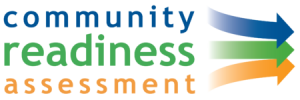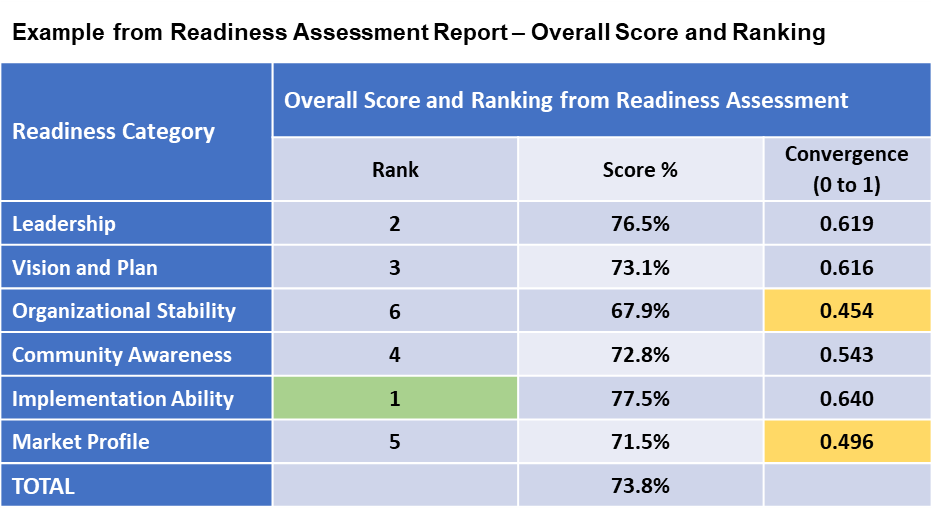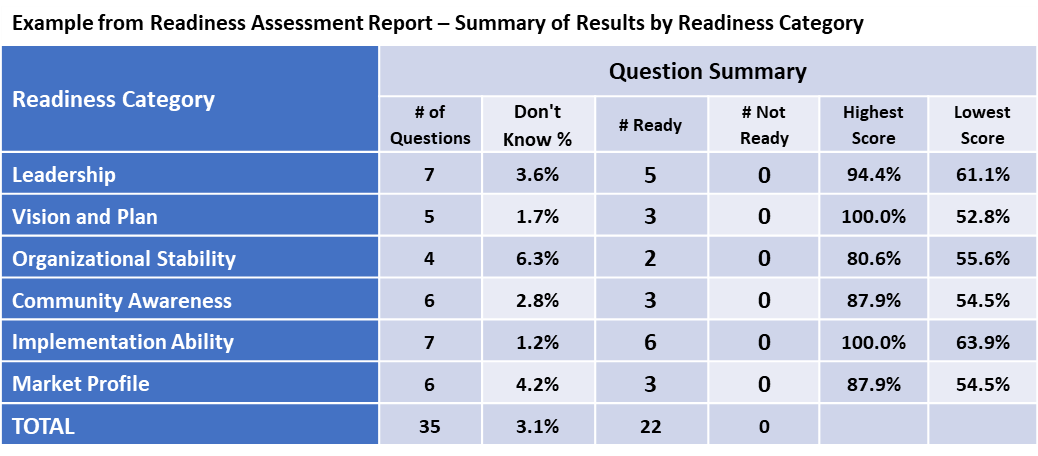Digital Needs and Readiness Assessment
You have decided to move forward with digital infrastructure – but are your local leaders and stakeholders aligned … and ready?
The Digital Needs and Readiness Assessment (DNRA) provides community leaders an objective assessment of where key local stakeholders have consensus on goals and issues that can be addressed through digital infrastructure, as well as an assessment of the current state of broadband and readiness to move forward with an initiative. The DNRA uncovers varying perspectives across stakeholders – whether there is alignment on project success criteria, or whether there are gaps in perspectives or approach. Time, money, and political capital can be saved and common pitfalls avoided by identifying and addressing these gaps early in the planning process. Building a shared vision among elected officials, community leaders, and local stakeholders will grow buy-in around strategies and commitments for the project participants.
The DNRA is normally deployed with the cooperation of one or more local leaders to members of the leadership team in the locality interested in a broadband or smart community initiative. The process is designed to be streamlined to make the most effective use of participant time.
“By taking the Digital Needs and Readiness Assessment, we saved two years in planning for broadband for the city.”
Nate Rivera
General Manager at Hermiston Energy Services
City of Hermiston, Oregon
A systematic approach to get ready and ensure that your leaders and key stakeholders are on the same page to address broadband gaps

Does your community have what it takes to address digital infrastructure and digital inclusion needs, avoid pitfalls, and get your project across the finish line?
Whether building-out broadband, digital infrastructure, or a digital inclusion initiative, there are critical success factors for readiness and sustainability that SNG has analyzed from our extensive research, data collection, and experience with digital infrastructure projects across North America. We have developed objective metrics to assess whether communities are ready to invest in these initiatives and whether those projects will be sustainable. Elected officials, local leaders, and key stakeholders want assurance that your projects have a high chance of success and will prove to be a good investment for the community.
SNG’s Digital Needs and Readiness Assessment enables localities to understand if they have the right resources, skills, commitment and support to efficiently and successfully complete their projects. The assessment also uncovers varying perspectives across stakeholders – is there alignment, or are there gaps in perspectives and/or approach? Time, money, and political capital can be saved by identifying and addressing these gaps early in the process.
Whatever strategy and plan you choose to address your community’s digital future needs, actually making it happen requires consensus and collaboration. Engaging stakeholders across your community in this process is foundational and SNG identifies the success factors and critical metrics under six major categories below:
| Leadership | Commitment of community leadership through all stages of the project. |
| Vision and Plan | Clarity and focus on the ‘why’ of broadband and how technology will help the community |
| Organizational Stability | Ability to follow through on the initiative over the timeframe. |
| Community Awareness | Awareness and support of residents, businesses, and stakeholders. |
| Implementation Ability | The availability of resources and local capacity to follow through. |
| Market Profile | Assessment of the current and potential demand for broadband services. |

The DNRA Assessment Tool
The Digital Needs and Readiness Assessment is an online questionnaire that typically takes less than 10 minutes to complete. The questionnaire consists of 25 questions, most of which are multiple choice with a few optional questions to provide additional comments. The assessment can be accessed via a web page link and requires password access. The link and password can be provided to those local leaders invited to participate in the DNRA.
Leaders completing the assessment will immediately receive a summary report by email with their individual responses for reference. The DNRA can be taken by one person or by multiple leaders in the locality. In the latter case, when a sufficient number of participants have completed the DNRA, SNG processes the responses for analysis and reporting. The online data collection tool uses a world-class system that ensures the privacy and security of participants, and individual responses are treated as confidential.
The DNRA Report
While a community and its leaders can go through this process on their own, too many projects have become roadkill on the information highway. Your elected officials, local leaders, and key stakeholders will want to be assured that your project is ready, your stakeholders are in alignment, and your community has what it takes to get your project across the finish line. SNG has applied our experience and methods to develop tools that helps communities achieve their digital goals more quickly and cost effectively, while avoiding pitfalls. Our Community Readiness Assessment tools are designed to easily engage community stakeholders in the process and provide a comprehensive readiness report to identify gaps and close them to get everyone on the same page, build buy-in, and avoid unanticipated issues before they happen.

The Digital Needs and Readiness Assessment is for multiple participants (e.g. council, leadership team), includes a report, and a one hour consultation to review and discuss findings. If your readiness scores indicate your community is not ‘ready’, you can take the assessment again once you have addressed identified gaps in readiness and alignment with your elected officials and local leaders. For an example of what is included in a report, see Excerpt from Digital Needs and Readiness Assessment Report.

The DNRA Report summarizes the results of inputs provided by the participating leaders from the locality. The collective responses of the participants are summarized in this report using the following scoring system:
- Individual responses to questions are scored, with higher scores representing more positive response categories – with 100% being the maximum and best score
- An average of the individual participant scores provides an overall score for the question. Score are presented as percentages, with 100% being the maximum and best score.
- Since individual participants do not always agree in their responses, the relative convergence level is calculated on a percentage scale. A convergence of 100% indicates complete agreement among all participants.
- When there is disagreement, the consensus result chosen by a plurality of participants is provided.
The intent of the DNRA scoring system is to reveal areas where the locality may be more ready, or less ready to move forward successfully, as well as areas where more agreement may be required. The scoring is not intended to be “pass or fail” criteria, but as an aid in quickly identifying areas that need attention.
To aid readers in understanding the findings from this report, thresholds are set to distinguish the top one-third (above 66.67% in green shading) and the bottom one-third (below 33.33% in red shading). For example, when evaluating the readiness criteria, the top one-third indicates a high level of readiness, while the bottom one-third indicates a low level of readiness.
Other DNRA questions, such as those related to community goals and issues, are scored for ranking and determining convergence of opinions. There are no right or wrong goals or issues. Where there is divergence of opinion among the leadership team, those gaps need to be identified, understood, and agreed about how to address them. For each response category, the “consensus” choice is shown representing the selection of the majority of respondents.
A number of factors are scored and included in an overall assessment score. An overall score above 71% is a good candidate for pursuing a broadband infrastructure project. Localities with a score below 50% are likely unready to move forward. Those above 50% may be in the process of becoming candidates, but require more information.
The DNRA Report is approximately 10 pages and is structured around the following sections:
- Recommendations
- Introduction
- Digital Needs and Readiness Assessment Summary
- Goals, Issues, and Needs Findings
- Broadband Status Findings
- Readiness Assessment Findings

Each section provides an average score and convergence level for each DNRA metric, an overall assessment, and any verbatim comments provided by the participants.
Assess your Locality’s Readiness for a Digital Infrastructure Initiative
Have your elected officials, local leaders, and key stakeholders take our easy to use Digital Needs and Readiness Assessment designed for multiple community stakeholder participants.
Engaging elected officials and local leaders to take the Digital Needs and Readiness Assessment enables them to see whether they are in alignment and where there are gaps, with a full analysis report. This is a systematic approach to get each stakeholder ready. Furthermore, the process of engaging local stakeholders builds their buy-in to your community’s broadband initiative.
Get started with SNG’s Digital Needs and Readiness Assessment to to get everyone on the same page, build buy-in, and avoid unanticipated issues before they happen.
Let’s Get Started – contact us to start your Digital Needs and Readiness Assessment
"*" indicates required fields


